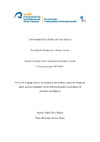Please use this identifier to cite or link to this item:
https://accedacris.ulpgc.es/jspui/handle/10553/126701
| Title: | El uso del lenguaje claro en la comunicación médica a través del folleto de salud: análisis contrastivo de dos folletos dirigidos a cuidadores de pacientes oncológicos. | Authors: | Pérez Negrín, Nadia | Director: | Álvarez Pérez, Beneharo | UNESCO Clasification: | 570113 Lingüística aplicada a la traducción e interpretación 32 Ciencias médicas 570112 Traducción |
Keywords: | Folleto de salud Cáncer Lenguaje claro Cuidador Paciente oncológico, et al |
Issue Date: | 2023 | Abstract: | El folleto de salud es una herramienta eficaz para la divulgación de información de carácter médico. Su brevedad y naturaleza generalista lo convierten en un recurso útil para que pacientes y allegados se informen sobre asuntos sanitarios. En ocasiones, sin embargo, la redacción de estos documentos es demasiado especializada para la población general y no se hace hincapié en la comunicación entre el paciente y su entorno. En esta investigación nos centraremos en folletos dirigidos a cuidadores de pacientes oncológicos, con el objetivo de comprobar si cumplen con los requisitos de ser entendibles para el público general y de tratar la comunicación entre el enfermo y su red de apoyo.
Para ello, se ha llevado a cabo un análisis contrastivo de dos documentos, uno en español y otro en inglés, siguiendo las pautas y recomendaciones de expertos en lenguaje médico, folletos de salud y lenguaje claro. Los resultados revelan que el diseño y el léxico de ambos folletos parecen adaptarse al público meta, pero que la comunicación entre paciente y cuidador, o bien pasa desapercibida, o no se trata en profundidad. Por lo tanto, podría concluirse que, si bien en la elaboración de los folletos se han seguido pautas relacionadas con determinados parámetros estudiados, sigue siendo imperativa una investigación más exhaustiva sobre cómo debe comunicarse el entorno con el paciente. Health information leaflets are an effective tool for the dissemination of medical information. Its briefness and generalist nature turn it into a useful resource for patients and their next of kin to be informed about health matters. Yet, sometimes the wording of these documents is too specialised for the general population and the communication between patients and their environment is not emphasised. In this research we will focus on leaflets aimed at caregiver of oncological patients, with the goal of verifying whether they meet the requirements of being understandable for the general public and of addressing communication between the patient and their support network. For this purpose, a contrastive analysis of two documents, one in Spanish and the other in English, has been conducted following the guidelines and recommendations of experts in medical language, health leaflets and plain language. The results reveal that the design and vocabulary seem to be adapted to the target audience, however, the communication between the patient and the caregivers is either overlooked or not dealt with in depth. Consequently, it could be concluded that, although guidelines related to certain parameters studied have been followed in the development of the leaflets, further research on how the social environment should communicate with the patient is still imperative. |
Department: | Departamento de Filología Moderna, Traducción e Interpretación | Faculty: | Facultad de Traducción e Interpretación | Degree: | Grado en Traducción e Interpretación: Inglés-Alemán | URI: | https://accedacris.ulpgc.es/handle/10553/126701 |
| Appears in Collections: | Trabajo final de grado |
En el caso de que no encuentre el documento puede ser debido a que el centro o las/os autoras/es no autorizan su publicación. Si tiene verdadero interés en el contenido del mismo, puede dirigirse al director/a o directores/as del trabajo cuyos datos encontrará más arriba.
Show full item recordPage view(s)
310
checked on Feb 22, 2025
Download(s)
199
checked on Feb 22, 2025
Google ScholarTM
Check
Share
Export metadata
Items in accedaCRIS are protected by copyright, with all rights reserved, unless otherwise indicated.
